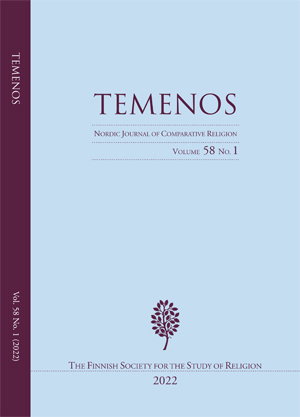Otherworldly Beings in the Pre-Christian North
Tribal, Chiefdom, and Archaic Religion and the Use of Cultural Evolutionary Theory
DOI:
https://doi.org/10.33356/temenos.102495Keywords:
pre-Christian Nordic religion, cultural evolution, cultural evolutionary theory, ontology, dispositions of being, Robert N. Bellah, Philippe Descola, álfar, vanir, tribal religion, chiefdom religion, archaic religion, otherwordly beingsAbstract
The interplay between societal and cultural change consists of a host of different factors. Religious conceptions are just one and are this article’s focus. Various conceptions of Otherworldly beings can be found in the textual sources for pre-Christian Nordic religion. To better understand these differing descriptions, one can employ various theoretical frameworks when constructing the particular model for the reconstruction of pre-Christian Nordic religion. For this article a cultural evolutionary framework inspired by the work of Robert N. Bellah is paired with a model of ontology in a case study suggesting that specific types of Otherworldly beings belong to specific types of religion. It is suggested that Otherworldly beings such as the álfar may represent what might be termed a tribal religion, while Otherworldly beings such as the vanir seem to belong to an archaic religion. The proposed intermediate category of chiefdom religion is then suggested as relevant for a different kind of Otherworldly being, which is explored by applying Phillipe Descola’s work on ontology. These differing groups of Otherworldly beings further seem to fulfil similar functions while remaining relevant throughout our textual corpus. This is ultimately seen as an example of Bellah’s notion that ‘nothing [important] is ever lost’.

Downloads
Published
How to Cite
Issue
Section
License
Copyright (c) 2022 Simon Nygaard

This work is licensed under a Creative Commons Attribution 4.0 International License.
Author's Guarantee
- The Author acknowledges that the Work will be publicly accessible on the Internet and that such access will be free of charge for the readers.
- The Author guarantees that the Work is her/his original work that has not been published before and cannot be construed as copying or plagiarism. Furthermore, the Author confirms that the Work contains no statement that is unlawful, defamatory or abusive or in any way infringes the rights of others.
- The Author confirms that she/he has secured all written permissions needed for the reproduction in the Publication of any material created by a third party.
User Rights
Under the CC BY 4.0 license, the Author/s and users are free to:
- Share — copy and redistribute the material in any medium or format,
- Adapt — remix, transform, and build upon the material for any purpose, even commercially,
- However, the Work must be attributed to the original Author and source of publication.
The license of the published metadata is Creative Commons CCO 1.0 Universal (CC0 1.0)
Author Rights
The Authors maintain the right to:
- copyright, and other proprietary rights relating to the Work,
- the right to use the substance of the Work in future own works,
- the right to self-archiving/parallel publishing (publisher's PDF allowed).
Rights of Publisher
- The Publisher reserves the right to make such editorial changes as may be necessary to make the Work suitable for publication in the publication, e.g. style of punctuation, spelling, headings and the like.
- The Publisher will publish the Work if the editorial process is successfully completed and reserves the right not to proceed with publication for whatever reason.
- The publication entitles the author to no royalties or other fees. This agreement will be governed by the laws of Finland.






